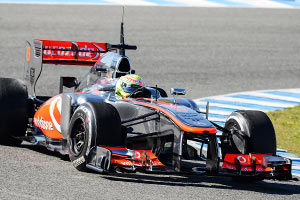beelsebob wrote:
Do they? Have you seen their CFD models and wind tunnel results? How do you know that's what they're using them for?
On the other hand, do you know what they are used for?
Notably, where most teams use multiple elements is in fact right in front of the front wheels. The reason for that is simple – they can extract maximum downforce from air hitting the front wing there that is going to go straight into the front wheel,
No, they use multiple elements there to inject air to the underside of the wing. This is done to prevent stall from that wing section, the outer section is a very sensitive part of the wing due to the Front wheel it's influence there.
So with that, stall is prevented in that area, this gives less peak downfore (more elements =/= more downforce) but more consistent downforce as there is more consistent flow on the underside and the area is less effected by the front wheel.
so they can't control how it flows back down the car anyway.
They can, that the flow doesnt stall in that area has a huge effect on how it is sent around the tire. Also teams have modified their wheel hubs so they blow clean air out of the wheel, which has a benificial effect on the front wing itself, as well as a positive effect on the air downstream.
For example Williams uses this solution, they have a whole duct in that area as well as a 'blown axle'.
Yes, they create turbulent ariflow and more drag, but also better airflow control and redirection.
No, it allows the air to stay attached to a steeper AoA front wing.
Both are right. Yes a multiple plane wing has more drag than an single plane wing with the same AoA, but it is also less sensitive, which is mainly a goal in this outer section. Also because it doesnt stall the airflow can be controlled better.
It is always a compromise. Hence why I said "efficient downforce creation" in the case of the mclaren situation, which most certainly has a better L/D.
Actually, it almost certainly has worse L/D than the other wings – but also has less turbulent flow coming off the back of it.
What makes you think that? so you are actually saying it has less turbulence from the wing(which would rougly translate to less drag) but it's larger planes would generate more df compared to the other wings. So that would translate to a higher L/D. Too bad that L/D isn't everything though.
I say almost, because I haven't seen their CFD or wind tunnel results either, so I can't know for sure. But, the basic aero theory is that McLaren's wing will produce less downforce, and a cleaner airflow to the back.
I am sure it would produce more downforce. Why?
In my previous post I showed how other Front wings evolved, but McLarens didnt. I picked 2010/2013 for every team I had shown.
But to get back to 2010, they had DDD back then, F-Ducts, and also the EBD. Cars then had more rear downforce than they have now. This had to be balanced out by the fornt df. So then they had more rear df, and also needed more front df. So back then Front Wings were much more about downforce production, because they needed to make more front df. With the cuts in rear df(ban of DDD etc.) the front df has to follow too. So with that, Front Wings are much 'easier' parts, they dont need to generate lots of df any more and became more of an device to send better airflow to the back than to generate lots of df in it's own right.
So in that aspect, every front wing changed in 2013, except for McLarens, which is still pretty similar to 2010, the year that Front wings were still about generating lots of df, so therefore I'd say the McLaren front wing has more df than others, but on the other hand also has less effect on airflow itself and how it sends it rearwards.
So compared to 2010 there is a huge change in front wing philosophy, and everyone apart from McLaren changed it.

